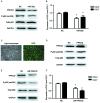Role of microRNA-26a in the diagnosis of lower extremity deep vein thrombosis in patients with bone trauma
- PMID: 29201216
- PMCID: PMC5704309
- DOI: 10.3892/etm.2017.5183
Role of microRNA-26a in the diagnosis of lower extremity deep vein thrombosis in patients with bone trauma
Abstract
The present study aimed to investigate the role and mechanism of action of microRNA (miR)-26a in deep vein thrombosis (DVT). Peripheral blood was collected from 45 patients with DVT and 40 healthy controls. Levels of miR-26a, chemokine C-C motif ligand (CCL)2 mRNA and CCL7 mRNA were detected using reverse transcription-quantitative polymerase chain reaction and the value of miR-26a in the clinical diagnosis of DVT was assessed using receiver operating characteristic curve analysis. The correlation of miR-26a with CCL2 and CCL7 levels was analyzed using Spearman's rank correlation. In addition, miR-26a and protein kinase C δ (PRKCD) were overexpressed in human umbilical vein endothelial cells (HUVECs) and PRKCD expression was knocked down by small interfering (si)RNA. Western blotting was conducted to detect the expression of PRKCD and p65. Furthermore, a dual-luciferase reporter gene assay was performed. The results of the current study demonstrated that the expression of miR-26a was significantly downregulated in the peripheral blood of patients with DVT compared with healthy controls (P<0.05) and negatively correlated with CCL2 and CCL7 levels (P<0.05). Furthermore, it was demonstrated that miR-26a markedly inhibited the expression of PRKCD, significantly decreased levels of CCL2 and CCL7 mRNA (P<0.05) and inhibited activation of the NF-κB signaling pathway. Overexpression of PRKCD in HUVECs inhibited the effects of miR-26a and markedly upregulated the phosphorylation of p65. The present study indicated that miR-26a directly targets PRKCD mRNA and that miR-26a may be a useful biomarker in the clinical diagnosis of DVT. Thus, the present findings suggest that miR-26a regulates the NF-κB signaling pathway by binding to PRKCD mRNA, inhibits the expression of CCL2 and CCL7 and reduces the risk of DVT.
Keywords: clinical diagnosis; deep vein thrombosis; microRNA.
Figures




References
-
- Van der Hulle T, den Exter PL, Planquette B, Meyer G, Soler S, Monreal M, Jiménez D, Portillo AK, O'Connell C, Liebman HA. Risk of recurrent venous thromboembolism and major hemorrhage in cancer-associated incidental pulmonary embolism amongst treated and untreated patients: A pooled analysis of 926 patients. J Thromb Haemost. 2016;14:105–113. doi: 10.1111/jth.13172. - DOI - PMC - PubMed
-
- Cho SY, Youn HJ, Park MY, Shim BJ, Lee SJ, Kim JH, Park JK, Oh CY, Ahn SH, Cho WH. Post-operative multiple thrombosis associated with patent foramen ovale: Embolic stroke, right atrial thrombi, pulmonary embolism and deep vein thrombosis. J Cardiovasc Ultrasound. 2015;23:177–180. doi: 10.4250/jcu.2015.23.3.177. - DOI - PMC - PubMed
LinkOut - more resources
Full Text Sources
Other Literature Sources
Miscellaneous
